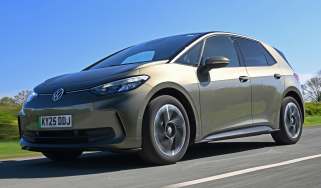Honda e:Ny1 - Interior, design & technology
Sensible and understated design contrast with a slightly disappointing infotainment system, but you can’t argue with the kit list.

The Honda e:Ny1 has been designed to conform visually with the rest of its SUV line-up. In that sense, it’s not an EV that tries to remind everyone that it’s running on battery power. You’ve got the body-coloured panel (that can be specified in black plastic as an option) hiding the charging port at the front in place of a traditional grille, and that’s the main clue to this being an EV. The shape has much in common with a traditional SUV, although the sloping rear window and roof spoiler give a slight coupe-SUV flavour.
Up front, things feel premium in most places; you’ll find some scratchier plastics on the very top of the dash and lower down on the doors, but everything you touch regularly is covered in soft materials. Build quality seems generally robust.
The two trim levels start with Elegance. It’s very well appointed for an entry-level car with wireless smartphone charging, heated front seats, keyless entry, keyless start, front and rear parking sensors and a reversing camera are all included. The second option is the plusher Advance specification that adds a panoramic sunroof, a powered tailgate, a heated steering wheel, side parking sensors and an upgraded stereo, among other features. While those are nice features to have, we think that the Elegance trim will make sense for most buyers, and it saves you over £2,000 compared with the top-of-the-range Advance model.
Optional extras are limited to the cosmetic, so it’ll come down to personal taste. There are six paint colours to choose from, four different 18-inch wheel designs, and the option to have the front panel (including the charging door) painted black.
Sat-nav, stereo and infotainment
The vast 15.1-inch portrait display screen in the Honda e:Ny1 stands out in the class. However, get over the impressive size, and things aren’t so brilliant. It might look like a single touchscreen unit, but it functions like three separate screens. The top section is for navigation and smartphone connectivity, the middle is for the main menu tiles, and the bottom area is for heating and ventilation. It means that although the screen is large, it doesn’t really make full use of all the real estate.
The screen is responsive and looks fantastic, but the mapping area is relatively small, and many on-screen keys are fiddly, while both of the upper sections have their own row of shortcut keys for ‘back’ and ‘home’, which can be confusing at first glance. We also had constant issues trying to connect our smartphone to Android Auto. The Premium Audio upgrade you get with the Advance model delivers fantastic sound quality.










